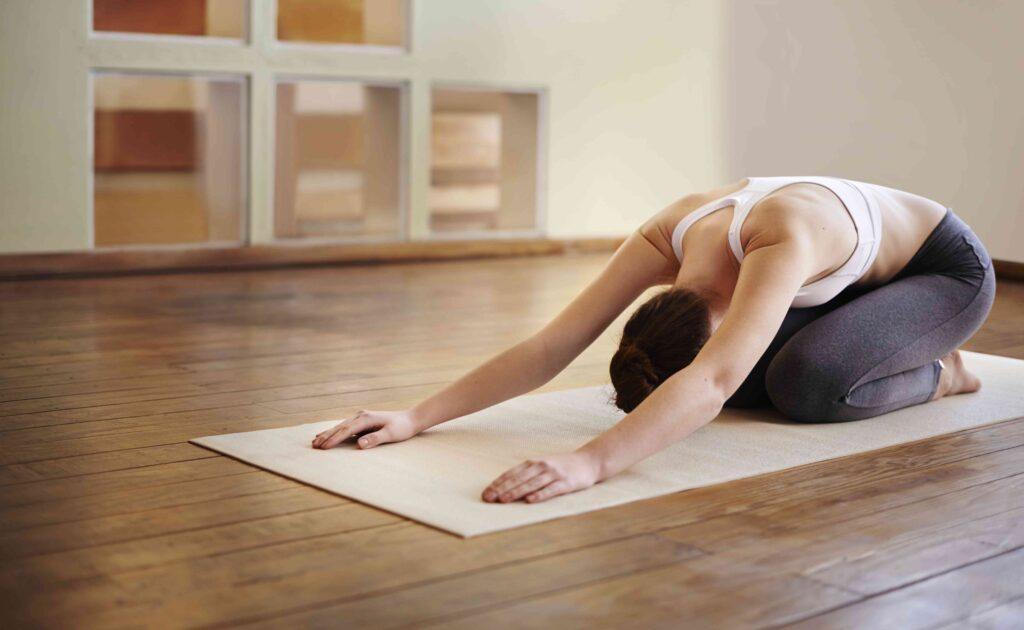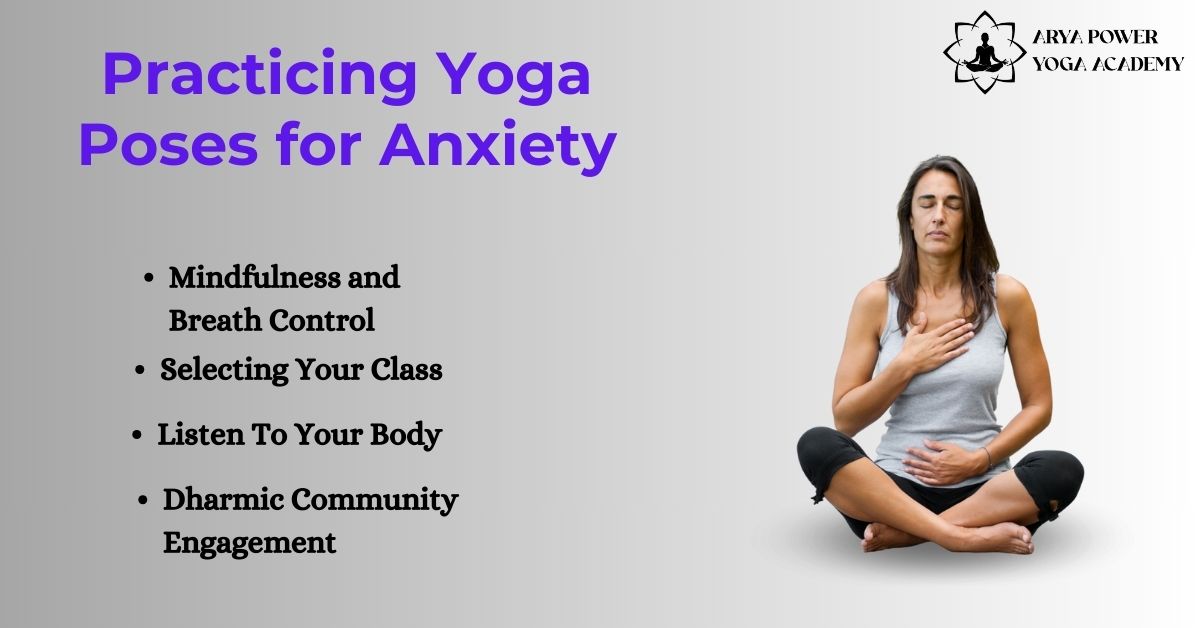admin
October 10, 2024
10 Yoga Poses for Anxiety Relief

The fast world is causing anxiety to an American, and this has led to anxiety disorders in about 40 million adults in the United States alone. Surely this is a staggering figure that underlines the need for effective coping strategies that can immediately get met if we have to suffer from such a pressing problem. Among the practices that can be applied to deal with anxiety, yoga poses for anxiety is one of the holistic disciplines that aim to integrate physical movement, breath control, and mind. In an individual’s practice of yoga for anxiety, comfort from anxieties is felt and the ability to motivate their entire mental and physical parts is possible.
In the article that follows, we will venture into 10 yoga poses for anxiety that make a person calm and at the same time improve his mental health. Those chosen pose here are those that are effective in the releasing of anxiety and can easily be incorporated into the everyday routine. Whether a seasoned yogi or someone who is just discovering yoga with the challenges of anxiety these can aid in one’s journey to a more serene mind.
What is Anxiety?
An anxiety is described as the feeling of worry, fear, and apprehension. Generalized anxiety disorder, panic disorder, social anxiety, or specific phobias are some subtypes of anxiety disorders. Some symptoms include restlessness, fatigue, irritation, a hard time concentrating, muscle tension, and disturbances in sleep.
Anxiety can significantly affect an individual and many facets of life. It has implications on the quality of work, human relationships, and the quality of life. Fear or apprehension, which can be cumulative, places patients with anxiety in avoidance behaviors, thereby heightening feelings of alienation and stress.
Relation to Yoga
Yoga can attack anxiety from multiple dimensions in the present. It is not only confined to the physical body but also understands and balances with breath, as in pranayama and intellect and consciousness, as in asanas, thereby integrating a person with his or her body and mind. This holistic approach does it by allowing emotional resilience and teaching tools of self-regulation which reduce and manage anxiety.
Yoga benefits over anxiety
Mind-Body Connection
Yoga for anxiety for beginners takes one to an association with the body and the mind. This yoga practice promotes awareness, which then enables one to become aware of how tension in the muscles or even shallow breathing could be presented in manifestations of anxiety. With this consciousness, a person is empowered to exhibit thoughtful responses toward the perceived tensions. In such a state of awareness, one can be taught how to break the cycle of anxiety before it gets too late. This contraction not only gives you the toned body but also strength. Increased glute strength improves your posture and general stability, which is more important in other exercises. Therefore, it is an excellent addition to any exercise routine, regardless of whether you are a seasoned athlete or just starting out on your road to fitness.
Physical Benefits
The yoga poses for anxiety releases tension that is stored in the body. Many of the yoga poses prove to have relaxing effects for the body, improve flexibility and circulation, and help to counteract much of the physical manifestations of anxiety within the tight, aching areas of the body.
Psychological Benefits
It mainly contributes to mental well-being by regulating the moods and increased clarity in mental processing. Several studies have been conducted that show that witnessing a proper schedule of yoga practice helps curb the levels of cortisol, the stress hormone, in the body. In addition, yoga poses for anxiety features mindfulness and presence, which is an essential requirement in handling anxious thoughts and feelings.
Top 10 Yoga Poses for Anxiety

Balasana, Child's Pose
Practice: On your hands and your knees approach a tabletop position. Move back on your heels while you reach forward with your arms, and then place your forehead on the floor. You can keep your knees close together or have them far apart to achieve a deeper stretch.
Benefits for Anxiety: This is one of the best yoga poses for anxiety and depression that calms and stills the mind, making it a perfect asana for reflection and centering. It also is a gentle stretch for the lower back and tension relieving .
This yoga pose for constipation helps by energizing the digestive organs as well.
Cat-Cow Stretch (Marjaryasana-Bitilasana)
aInstruction: All fours, push wrists forward under shoulders and knees back under hips. Inhale arching back (Cow). Look forward and up curling underneath your tailbone. Exhale rounding your back (Cat). Chin and pelvis tucked in.
Benefits for Anxiety: This yoga pose for anxiety helps easy flow between poses, increases flexibility in the spine and develops pulsing breathing that quietens the nervous system and diminishes stress.
The effects of Bridge Pose on mood make it a great pose for those with low energy or emotional challenges, because it tends to create a feeling of joy and lightness, making your mental health more disposed to and improving your quality of life.
Forward Bend (Uttanasana)
Instructions: Stand with feet hips-width apart. Breathe in and bring arms up overhead. Exhale, folding forward from hips, letting head dangle in. A slight bent knee can support you if needed. It relaxes the nervous system and cultivates introspection, which makes humans less overwhelmed.
Legs-Up-the-Wall Pose (Viparita Karani)
Instructions: Sit sideways on the floor beside a wall, swinging your legs up against the wall as you lie back and brace your body in your arms at your sides or resting on your belly.
Benefits for Anxiety: It will relax the tension of the legs and provide the feeling of stability and being grounded. This also will soothe the mind and relieve drowsiness.
Paschimottanasana-Seated Forward Bend
Sit with your legs straight out in front of you. As you inhale, lift your chest and stretch out your back. As you exhale, stretch forward as far as possible toward your toes and keep your back long and straight.
Benefits for Anxiety: This asana helps in cleansing the mind, allowing one to take deeper breaths to fill him or her with a sense of tranquility.
Corpse Pose (Savasana)
Instructions: Lie on your back with arms by sides. Palms facing up. Close your eyes and breathe normally, relaxing the entire body.
Anxiety Benefits: This corrective pose ensures full relaxation and stillness of mind; therefore, one gets rid of anxiety and stress.
Corpse Pose (Savasana)
Instructions: Lie on your back with arms by sides. Palms facing up. Close your eyes and breathe normally, relaxing the entire body.
Anxiety Benefits: This corrective pose ensures full relaxation and stillness of mind; therefore, one gets rid of anxiety and stress.
Bridge Pose (Setu Bandhasana)
Lie on your back, bend your knees with your feet wide apart (as wide as is comfortable), and roll your hips up toward your head, coming up to press down through your feet. This will lift your hips off the floor. Your shoulders and head remain on the floor.
Anxiety Benefits: It expands the chest and heart space, offers a feeling of security and safeness, and can release tension in the upper back.
Warrior II (Virabhadrasana II)
Stand with feet wide apart. Turn your right foot out and bend your right knee, keeping your left leg straight. Extend your arms parallel to the ground, looking over your right hand. Benefits for Anxiety: This pose strengthens the student's and builds confidence, giving a reinforcement of reassurance against insecurity and fear.
Child's Pose Variation
Instructions: From Child's Pose, reach back and grab your ankles, stretching it even deeper while keeping the forehead on the mat. Benefits for Anxiety: This variation deepens the relaxing quality and encourages release.
Sukhasana (Easy Sit)
She sits upright on her back, with hands resting either on her knees or in her lap. Close your eyes and bring your inner focus to the breath. Uses for Anxiety: Sits well to build mindfulness and being here now, which is required to deal with anxiety and to have a sense of peace.
The digestive system also benefits from bridge pose. The posture stimulates the abdominal organs, and therefore it is useful for digestion and helps to alleviate gastrointestinal issues. Mild pressure and release generated through the asana will contribute toward better digestion and is a beneficial addition to any routine that is centered on gastrointestinal health.
Although still somewhat uncomfortable with bloating or constipation, practicing Setu Bandhasana can help to alleviate the discomforts of these conditions, making it helpful as an asana for someone in need of a better digestive well-being.
Practicing yoga poses for anxiety

These top 10 yoga poses for anxiety can change your daily pattern. Begin by choosing a practice you can dedicate 15 to 30 minutes daily and then narrow down to fewer postures. You can create a weekly schedule with variation of postures so that you can explore all the aspects of your practice.
Mindfulness and Breath Control
Most styles of yoga incorporate breathing exercises. Add slow, deep thoughtful breaths to every posture to enhance the relaxing effect and deepen your practice. For example, inhale to more fully fill the lungs upon entering the posture and exhale slowly upon letting go of tension. Mixing these techniques with pranayama, such as diaphragmatic breathing or box breathing, can help support your work in mitigating anxiety.
Selecting Your Class
Classes for anxiety-focused yoga for a beginner are helpful for the novice as well. Look for yoga studios or platforms that offer classes specifically designed to focus on relieving anxiety. Something like Arya Power Yoga Academy offers one boundless resources from guided classes and walk-through tutorials founded on managing anxiety.
Listen To Your Body
On the first principle, the guiding philosophy of yoga, listen to your body: respect its boundaries, be good to yourself. If a stretch is painful or gives you an emotional charge, modify it, take a break, and make the practice sustainable in all ways. For that matter, it's meant to give you the nourishment to improve both body and mind.
Where yoga poses for anxiety is a good tool, these other practices more often add value when used along with the yoga for anxiety and depression. Perhaps you can meditate, journal, or do mindfulness exercises alongside your sessions of yoga. These practices may complement your yoga and could serve as further aid towards reaping your quest for mental health.
Before you move into practicing yoga poses for anxiety, take an immediate setting of intention. It can be very specific, such as "I want to decrease my anxiety," or more general such as "I want to cultivate love for myself." Once again, setting intentions helps you stay focused and connected to what you are trying to do.
Dharmic Community Engagement
Joining a community of yoga poses for anxiety may provide greater support and encouragement. Involving those who have the same objectives gives one the feeling that he or she belongs to a community and keeps him or her motivated since he or she would be accountable for his or her practice.
A group class or forum online would be very helpful in this sense as it lets people share their experiences and insights with others.
Conclusion
The above yoga practice for mental health and relief of anxiety which are discussed in the article can contribute much in the management of anxiety, thereby improving the mental wellbeing of a person. Integrate these poses to your regimen and seek calmness, become resilient, and live better. Try them out. Learn to inculcate yoga poses for anxiety in your life.
Take the first step today-don’t try a little; try some, focus a bit on your breath, and take the ride of self-discovery that yoga poses for anxiety has for you. Tell others of your experiences to share with those who can use the calmness of the effect that yoga poses for anxiety has in the minds of people, and remember you’re not alone on this road to wellness.
Frequently Asked Questions
Yoga poses for anxiety prevents anxiety through leaving one feeling more relaxed when promoting mindfulness and contributing to overall physical and mental recovery. In addition, it offers tools for self-regulation and emotional resilience.
Most yoga poses for anxiety and all classes can be recommended for a beginner who wishes to get relief from anxiety.
The finer asanas are Child’s Pose, Cat-Cow Stretch, and Corpse Pose among others, all having a unique benefit to oneself, calming the mind and body.
Look for Arya Power Yoga Academy and find a variety of classes put together with the element of dealing with anxiety.
It is advisable to maintain it a few times a week so that maximum results are obtained. The practice renders a lot of resistance to anxiety.



